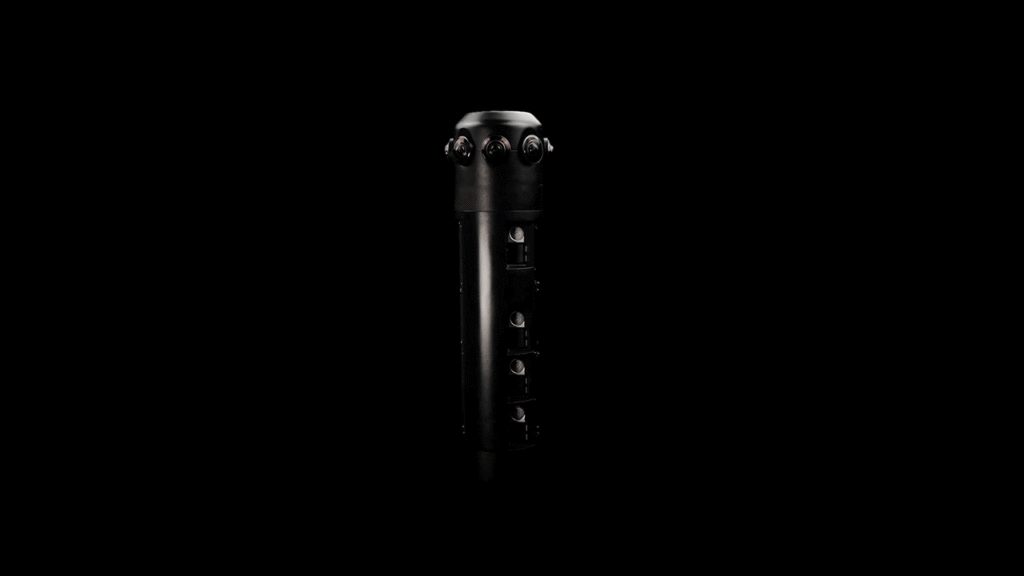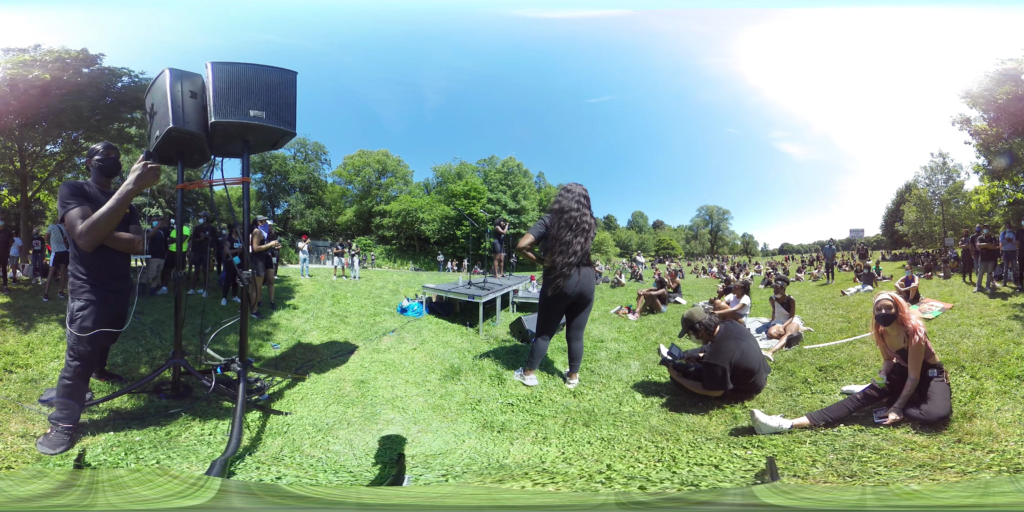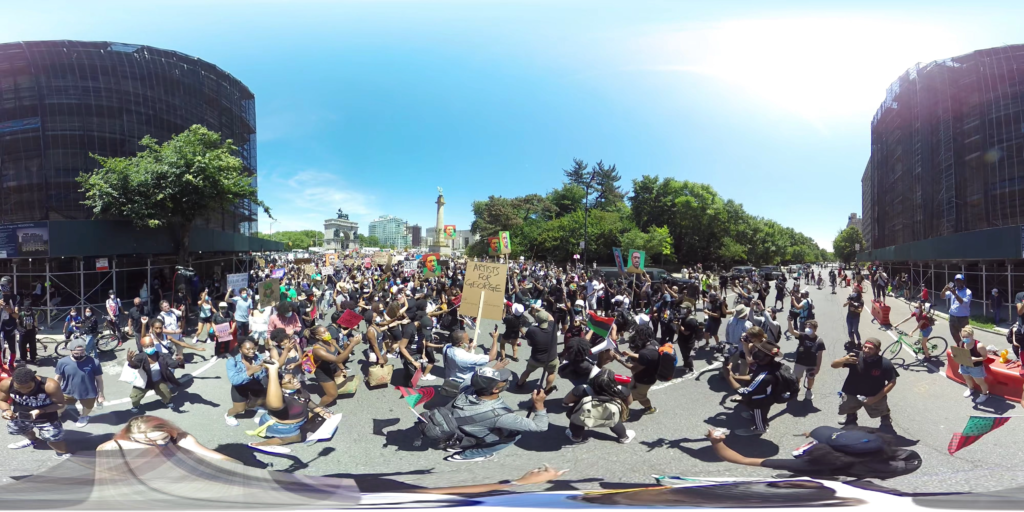The revolution will be documented in 360.
June 19th (a significant holiday in the United States denoting the end of slavery) this year was both a moment to pause and to celebrate, as well as strike up protests and marches across the country in demand of a better world.
2020 has been fraught with political discord at local and national levels, undeniably upsetting many, especially those bringing attention to the cause of equity for Americans of color. Two creators, Max Noir of FXG Technology of America, and Edwin Rogers, founder of VRvideo, sought out one particular gathering in Brooklyn this summer, hosted by the March For Our Lives organization, and documented the experience as a first-hand account of the intensity and energy at the event.
The educational testimony of this mini-doc features speeches from New York politicians, Senator Zellnor Myrie and Assemblywoman Diana C. Richardson, and showcases how peaceful, spirited and organized the march was months ago.
VRScout spoke with the creators of the aptly titled, Brooklyn Juneteenth 360 Experience, to hear about their creative process, political standings and the technical aspects regarding the shoot.
Why did you do this project?
Max Noir: “This Juneteenth march was already such a historic moment in itself. We wanted to capture that exact moment where people were coming together to speak out and being activated. By capturing this day through immersive 360 video, it would enable people who were looking back on this day in history, to experience it on an entirely different level. The added layer that 360 video brings lets people think they were part of this time in history.”
Edwin Rogers: “VRVideo.TV is a 360° video channel I have been developing. As a startup founder of color, I have been interested in creating immersive content around the Black Lives Matter movement. My first immersive journalism project was of the Eric Garner Protest in 2015 and I wanted to create another immersive protest video that showed how the protests have evolved. This time around we chose to use a 12K resolution 3D 360° video camera and to shoot the Black Lives Matter Protest in Brooklyn on Juneteenth. Protests were taking place in many parts of New York City on Juneteenth but as a Brooklyn native, I wanted to broadcast the voices in my community.”
What kind of hardware did you use?
Max Noir: “We used two different cameras. I’m not sure what Edwin used, but I used an FXG ET-2. It was shot in 4K stereoscopic. It really demonstrated the short shooting distance, which is 30cm for this camera..which allowed me to get some of those shots like the closeup painting and other closeups.”

Edwin Rogers: “We used custom-built 12K stereoscopic 360° 3D cameras to capture the Black Lives Matter march in Brooklyn on Juneteenth because of its amazing picture quality. Our work can be enjoyed in any VR headset as well as smartphones, tablets, and computers.”
What are your hopes?
Max Noir: “I have multiple hopes. One of them would be that people around the world who couldn’t be there that day could view this film and immerse themselves into that exact moment and feel like they were there. The other is that I hope it will help activate all of the people around the world who are feeling a bit passively empathetic. They care about the Black Lives Matter movement, but not activated enough to really participate or take actions. By putting yourself in a more immersive first-person type of view of those events that day, it places you at the protest and makes you feel this sense of community and, hopefully, you’ll exit the film wanting to be part of the movement.”
Edwin Rogers: “The news and media industries have made a profession of telling viewers what to think and I wanted people to experience history in a new visceral and unbias way. Max and I wanted to showcase the Black Lives Matter Protests that were happening in Brooklyn with the hope that anyone would be able to relive these events and feel what it was like to be there. 360° video allows the viewer to choose their own perspective. It is perfect for capturing historical news. Most major news outlets are afraid to innovate and produce journalism using new technologies. We at VRVideo.tv thrive on creative VR, AR, and XR innovation and hope to be a new source of amazing immersive content. In the future, we plan to live stream immersive news and events directly to phones and headsets.”
What does the Black Lives Matter movement mean to you?
Max Noir: “I guess it means living in a world where people are racially equal and privilege no longer becomes privilege. Instead, it becomes something that everyone has a right to. It’s always hard to talk about these things in a way that feels both completely accurate, sensitive, and from the heart but it also needs to feel truthful to you and it has to feel bigger than yourself.”

Edwin Rogers: “Black Lives Matter is a simple statement of truth created in response to the killing by police of unarmed Black men and women. To me, this movement means Black Unity around this truth and the protests send a clear message to the world. Attack one of us, deal with all of us and our allies.
I remember back in 2015 when Eric Garner was choked to death by Staten Island NYPD police officers. Black Lives Matters was one of many slogans on the hand-drawn posters and those protests but it stuck. Looking back at that work in hindsight I realize that 360° video has the power to transport viewers to see how the movement began.
The COVID-19 pandemic has made group protests even more dangerous, nevertheless, we wanted to march and share this experience. In the pandemic area, this is a social-distance safe way of experience a group event. Some people may be unable to attend the marches in NYC but now they can be there without risking their health.”
In 360 VR experience, the viewer can become the director, per say; they can focus on what they want to focus on or maybe they look away because they’re not prepared to face that moment. Do you think that personalization has a much deeper impact with the viewer?
Max Noir: “With 2D storytelling, you are only shown what the director wants you to see. Through 360 journalism. It’s the most unbiased type of video journalism that you can conduct. You can choose what you’re filming, but you can’t choose what’s going on around you. The audience is able to choose to fixate on a single subject or a single corner of the film if they wish and follow that. That enables them to view the experience over and over and over again, and by choosing a different subject each time, they would see different aspects of the film they didn’t see the first time.

In the end, they are in the middle of a protest and they chose to be there. Experiencing this moment in VR is a safe place for someone who maybe is not feeling activated. You have activated people already taking action. They’re already going to protest, making donations, reading books, and educating themselves. Then you have people who aren’t taking action. So by giving them this safe environment to put a headset on and have this experience without actually showing up, I think it gives them a lot of space to sort of figure out how they feel.”
Edwin Rogers: “Immersive filmmaking is a new art form that allows the viewer to receive made different experiences from the same content. You can watch it over and over again from a new perspective and notice something you missed. We want to create 360° videos that make you feel like you are a part of the event or walk in the shoes of another.”
What is next for your Juneteenth experience?
Max Noir: “This isn’t just a single project, this will be a series where we continue to film Black Lives Matters protests and capture as many stories as we can and have a YouTube series. But we’d also like to get this outside of the VR community and as many news outlets as we can. I would also love to get it into museums and classrooms.”
Edwin Rogers: “My next project will be focused on Black Lives Matter and other immersive news events. My goal is to use VR Video. TV as a platform to showcase stories of diverse backgrounds and to feature over-ignored in high-tech innovators.”
Feature Image Credit: FXG Technology of America
The post Mini-Doc Debuts Of Brooklyn Juneteenth March Captured In 360 Degrees appeared first on VRScout.
from VRScout https://ift.tt/2HcMZlT
via IFTTT
No comments:
Post a Comment